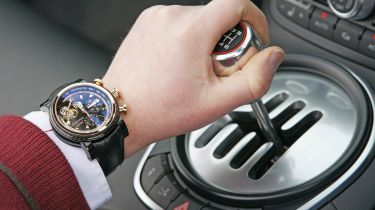R8 Spyder vs. Graham Tourbillograph
If it’s hand-built craftsmanship you’re after, for the same cash you can buy a luxury timepiece
It's often said that time is a luxury which can’t be bought – but that’s certainly not the case when purchasing a watch! The last of our trio of high-cost challengers for the R8 is not featured here for its performance, power and noise, but for its exquisite build quality and attention to detail.
The Graham Tourbillograph timepiece is more than a match for the Spyder in terms of craftsmanship and technical innovation. And with prices starting at £50,000 and rising to £100,000, these works of art are not much cheaper than your average supercar.
The British firm has been around for 15 years, but takes its name from famous inventor George Graham. Born in 1673, he pioneered a number of clock-making technologies and was commissioned to build the Master Clock for astronomers at the Royal Observatory in Greenwich.
This passion for innovation can be found in the Tourbillograph Silverstone Woodcote shown here.
Peer at the watch’s face, and you’ll spot a little window which reveals the inner workings of the Graham’s Swiss-made La Joux-Perret movement. The coupé version of the R8 takes a similar approach, with its engine visible through a glass panel, but the Spyder’s stunning powerplant is hidden away beneath a sculpted rear deck.
The Tourbillograph’s case will catch your attention, too, thanks to its mix of traditional 18-carat gold and hi-tech carbon fibre. Despite featuring the latter lightweight material, the Graham feels heavy on your wrist, while the winder and stopwatch have beautifully precise actions.
The Audi isn’t short of precision engineering, either. When bosses pulled the wraps off the R8 two years ago, they made a big fuss about the length of time it took to assemble the coupé. Adverts claimed the model was “the slowest car we’ve ever built”, as the German machine was shown being painstakingly put together by hand. The new drop-top is subject to the same labour-intensive process. The highlight of the technical package is its amazing 5.2-litre V10. This can propel the Spyder to nearly 200mph – although the downside is a fuel return of 19mpg, which will hit your wallet hard at the pumps.
Running the watch should cost you considerably less. Flip the Graham over and you’ll find a glass back which reveals more of the watch’s workings. Dominating the mechanicals is the large semi-circular weight which is the Tourbillograph’s engine. Every time you move your arm this device spins, winding the mechanism and keeping the timepiece ticking along for around two days before it needs recharging with another flick of the wrist. It’s a similar approach to the futuristic KERS energy-recovery systems which were used by a handful of Formula One teams last year.
Every Graham Tourbillograph model is limited to only 50 examples – so exclusivity is guaranteed. However, there’s no denying that in terms of value for money, the watch can’t match the incredible all-round appeal of the Audi. Neither can it provide the raw thrills associated with driving an exotic supercar. And if you want to get noticed with your six-figure purchase, then it’s the Spyder which passers-by will clock first...
Thanks to Martin & Co Jewellers, Cheltenham. For more information, see martin-and-co.com or call 01242 522821.



